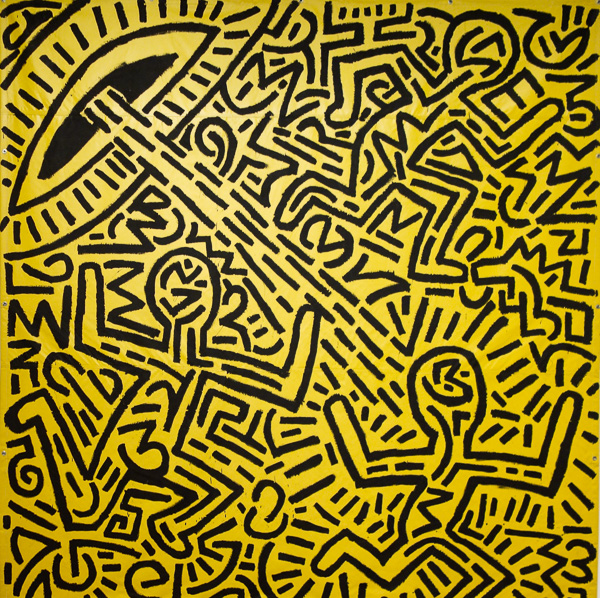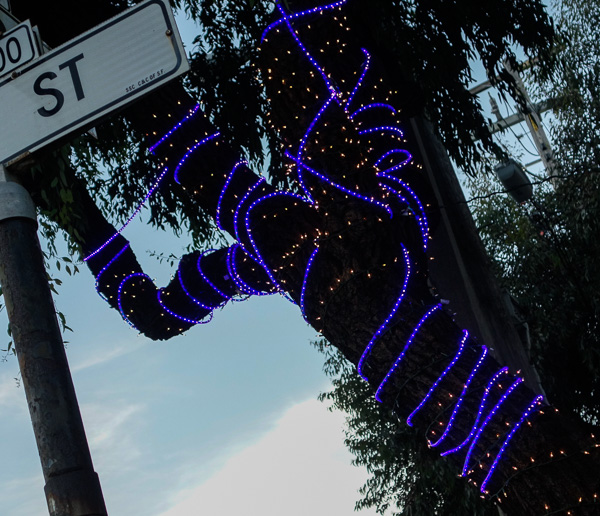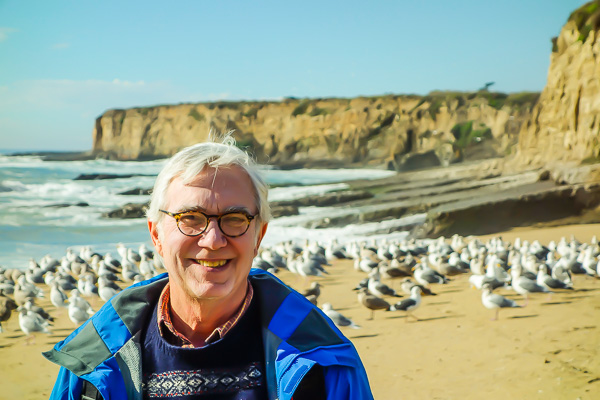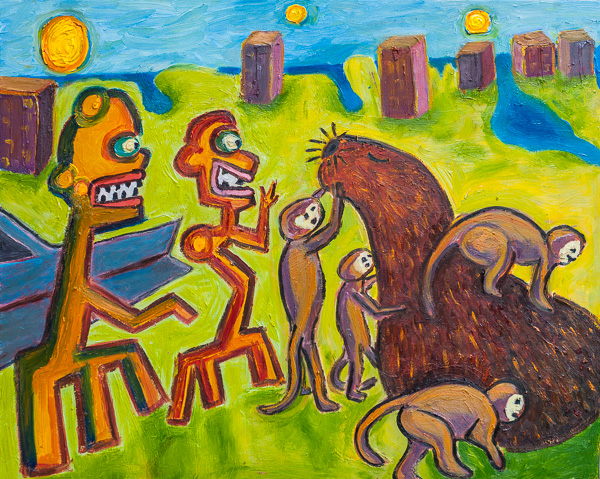I’ve mentioned in this blog that I want to write a novel about a very long road trip in a universe where Earth, instead of being a sphere, is more or less endless prairie, interrupted by mounts and seas, and with an utterly different civilization every ten thousand miles or so.

[Painting by Keith Haring, vinyl paint on a vinyl tarp.]
My working title is Million Mile Road Trip, and here’s a link to my blog posts about it.
I’ve decided to slant this new SF novel towards being a YA book. I might have a better shot at that fabled wider market that way, and it would be a nice change of pace for me. My 2004 novel Frek and the Elixir was in fact YA or even middle-reader (the hero was 12), but somehow nobody noticed.

The thing that makes YA seem feasible for me is that I’m free to write a YA without downgrading what I do. I realized this when went to the 2014 Nebulas in San Jose for an afternoon last year, and I attended a panel on YA writing. It included the writers Cynthia Felice, Erin Hoffman, Bennett Madison, and the redoubtable Ysabeau Wilce. They totally are regular writers, and I liked how casual they were about the middle-reader and YA genres, saying these were mainly marketing niches, and that older books such as Huck Finn or Catcher in the Rye or To Kill a Mockingbird might well have been put into those categories. They also said you should use whatever language you like, and not be hung up on using a limited-vocabulary word-list.

I’m free to write my YA SF novel as I see fit because, if I can’t get a publisher to take the novel, then I’ll just self-pub it via Transreal Books like I’ve been doing of late. But it might be fun to get a traditional publisher once again.
My agent John Silbersack pointed out to me that middle-reader and YA book editors are prickly about adult writers thinking they can just parachute in and do a book in their market. You have to be serious about it, or they reject you. You can’t be pretending. So it’s a matter of getting my head in the right place. In some sense thinking like a young person. Or like several of them. Not impossibly hard for me, given the kind of person that I am—a rebellious dreamer who refuses to “grow up.”

[Seen in the New Guinea collection upstairs at the DeYoung Museum in SF.]
Superficial observations:
A lot of YA books have short chaps. Makes them seem easy to read, I guess. Bam, bam, bam. Short attention spans these days (including mine).
In a YA novel, the main character has some special characteristic that the outer world has failed to recognize, or which the o. w. even views as a fault—but it just this particular quirk which allows our protagonist to access his or her wondrous adventure.
YA can allow you to make the book somewhat cartoony and parodistic. Like an episode of Futurama. You can use familiar tropes with new twists. Let the readers relax and wallow.

By way of research, I’ve looked at quite a few books on the YA shelves of bookstores and libraries, and some of them are really awful. Like TV. The book I don’t like use a limited-vocabulary first-person point of view that I find tiresome. The gushing, the slobbering, the emoting, the repetitious wheenk. Filtering everything through one limited person’s attitudes. This first person narration sucks all the air out of the room. But it doesn’t have to be that way.
I’ll want to make the narration contemporary and colloquial—without descending into a corner full-bore Valspeak. I mean, don’t make it corny, don’t try too hard.

While waiting to start my novel, I’ve been rereading Thomas Pynchon’s Gravity’s Rainbow once again. And, as usual, I’m trying to get a handle on the nuts and bolts of Pynchon’s narrative technique. Somehow I find this very difficult. I get so mesmerized when I’m reading the book that it’s hard to slow down and look behind the curtains. Putting it another way, peering at Pynchon’s style is like trying to stare at the sun.
I recently found a very useful description of the man’s style at the start of a longish 1996 work by Michael Davitt Bell (1962-1997), “Some Things That ‘Happen’ (More of Less) in Gravity’s Rainbow .” Here’s a lightly edited excerpt of the opening paragraphs of Bell’s valuable survey of the novel:

[Detail of a quilt by Sylvia Rucker.]
The book is narrated, throughout, in the present tense. Flashbacks (or events remembered by various characters) usually begin in the past tense, but they tend to shift rapidly into the present tense. The narrator is also capable, upon occasion, of flashes forward. Point of view shifts frequently and is sometimes indeterminate (or omniscient). And much of what ‘happens’ (it’s hard to say how much) is fantasy (it’s often hard to say whose).
So we’re talking about writing in a present tense head-hopping third-person point-of-view. You narrate it like you’re describing a movie, cutting from camera to camera in real time. Telling the story movie. You are there.

I had a first-person past-tense opening passage that I didn’t fully like. But then, working by the light of poor dead Bell’s pellucid lines, I switched my opener to the present tense, and put in a few spinning-wheels-of-the-mind asides, and looked into the minds of both my current chracters. I feel the story opening up. I think of compressed tea that comes in a block, and you flake out the stuff to brew it.
It’s working, I’ve started, I’ve got two very short chapters with two good characters, Zoe and Villy, on the eve of their high-school graduation, cantankerous off-beat kids, and they’re about to meet a pair of aliens.

[Rudy Rucker Jr. preparing Christmas dinner.]
As is often the case, I find it hard to actually be writing new material in my novel for more than an hour or so a day. I’m always looking for distractions. Waiting till my head is in the right place. Waiting for the level of dread-that-I’ll-never-write-again to build up to a sufficient level. Building up a big enough head of steam to turn the rusty wheels of this ooold locomotive.
And when I’m not exactly writing new words in the actual novel, I can pass my time correcting what I’ve written, or making plans in my already-30K-words-long Notes for Million Mile Road Trip document—I always make these huge book-length notes for each of my books, you can find them on my Writing page.

“Endless Road Trip” oil on canvas, Sept, 2014, 30” x 24”. Click for a larger version of the painting.
I already did a painting that relates to the novel, like the Endless Road Trip one I did a few weeks back. It’s good that I previsualized these two characters from “unfurled Earth,” as they just showed up in the novel, looking pretty much exactly like I painted them. That’s Pinchley on the left and Yampa on the right. The capybara and the spider monkeys will come later, I guess.
For my novel I shifted down from an “Endless” Road Trip to a “Million Mile” Road Trip, as the first option seemed too far! As another way to make starting this new project less intimidating, I told myself it might just be a novella. I’m always scared when I start a novel. Like getting in a rowboat yet again, with an intention to row from San Francisco to, like, Palau in Micronesia.
Whatever works. I may get this mofo going yet.









January 11th, 2015 at 4:46 pm
I stumbled upon your blog while looking for a Burroughs quote from “The Western Lands” and kept reading and looking – quite nice ….
January 11th, 2015 at 10:22 pm
Your description of the setting in the book immediately reminded me of Phil Farmer’s “Riverworld”. It’s not quite the same geometry, but perhaps similar effect?
January 12th, 2015 at 9:04 am
Thanks, Richard and Grego. I did read “Riverworld” not so long ago, and there is some similarity to what I have in mind, but not a lot. Riverworld is more or less an afterworld, and it features cameos of many famous people, which isn’t something I’ll be doing.
Paul Di Filippo and others have mentioned “Ringworld,” which is a little closer to what I have in mind…a really, really big world you can drive around on. It’s been nearly thirty years since read Ringworld…I’ll reread it soon. A difference is, I think, that my prairie world will have a greater diversity of species than Ringworld did. And my characters will have a really fast car.
My original inspiration for “Million Mile Road Trip” is actually a story by Charlie Stross: “Missile Gap.” One of my all-time fave SF tales. And, of course, whenever I’m talking road trip, I’m also thinking of Kerouac’s “On the Road.”
January 14th, 2015 at 12:44 pm
Larry Niven wrote about variations on ringworlds, which mostly come from Freeman Dyson, and he had an interesting one: shaped like an old phonograph record with the sun in the center. It would always be afternoon there. Karl Schroeder wrote a cool series about Virga, a sort of giant balloon with habitats inside, like Shaw’s ORBITSVILLE. But you want something more like Kansas.
Also, a nice quote from Dean Koontz: Once you have had a wonderful dog, a life without one is a life diminished. I thought of Arf immediately.
January 20th, 2015 at 7:52 am
I love that first painting, it’s got a sort of frantic feel to it.
January 22nd, 2015 at 8:15 pm
I’m looking forward to read the result of your efforts on this one. The possibilities are endless on an endless world! The fast car idea is good too; otherwise, lives would be spent just exploring a fraction of it.
There is something about your writing that makes me think that a lot of it could easily be considered ‘YA’ as well as ‘OA’ – old adult! You cross generations and reach out to all your readers, I think.
Although there have been other ‘large world’ stories, I expect you will take us to places no one has imagined before. Thanks!
January 24th, 2015 at 8:16 am
Really looking forward to this one and sharing it with my son. He’s 11 and recently picked up Cory Doctorow’s YA novel Little Brother — I didn’t even prompt it. He was intrigued by the Neil Gaiman endorsement on the cover. You are right that so much of YA is so bad. But I can tell you that kids are really into the present tense, “you are there,” mode of storytelling.
February 7th, 2015 at 1:28 pm
I read Riverworld, and what interested me also, and tell me if you noticed this: In the novel there is a replicator like machine that allows the people there to make different objects, and a mention is made of a sattelite-based version that turns energy from the sun into iron.
Rudy and others, do you think it is possible to convert subatomic nuclear particles into materials? The alla you mention in the Femtotechnology section of “Saucer Wisdom” is used to do that via the ‘quark flipping’. Guess what my friend: It turns out that quark flipping is possible, using longitudinal pressure waves, which are mechanical ‘sound waves’ in the structure of space itself: The ‘virtual particle flux” acts as a modern ‘aether’. The so-called empty space is not empty but filled with and made up of active virtual particles…and since all material changes (chemical, mechanical, nuclear, kinetic, etc) are all ultimately mediated by the virtual exchange forces, as quantum electrodynamics shows, once you could selectively tune and alter the virtual state, you can change and alter matter: And do exactly what you mention in Saucer Wisdom, Rudy.
This ability would make the material nano mechanical and bio nano mechanical chemical changes done seem quaint in comparison!